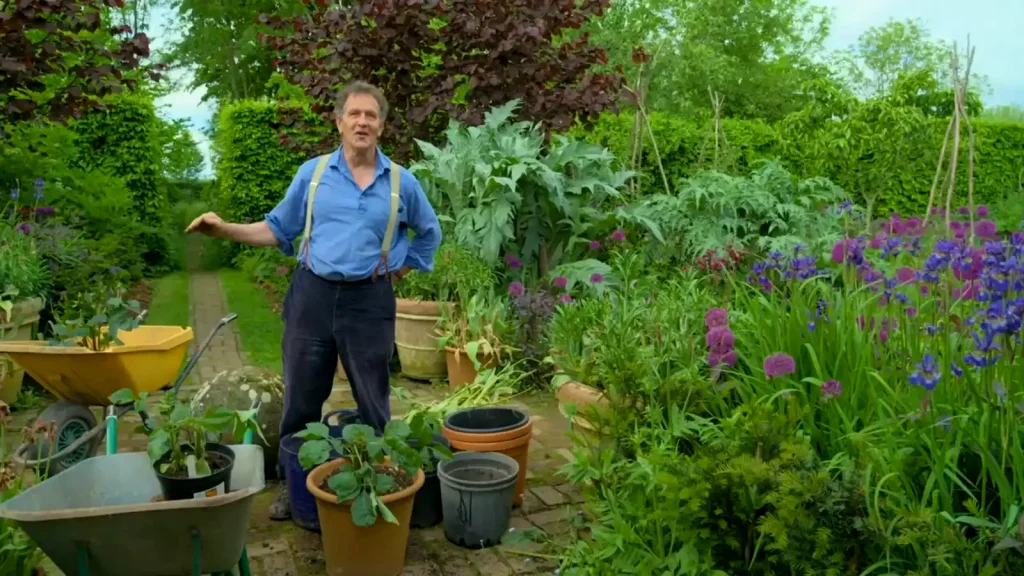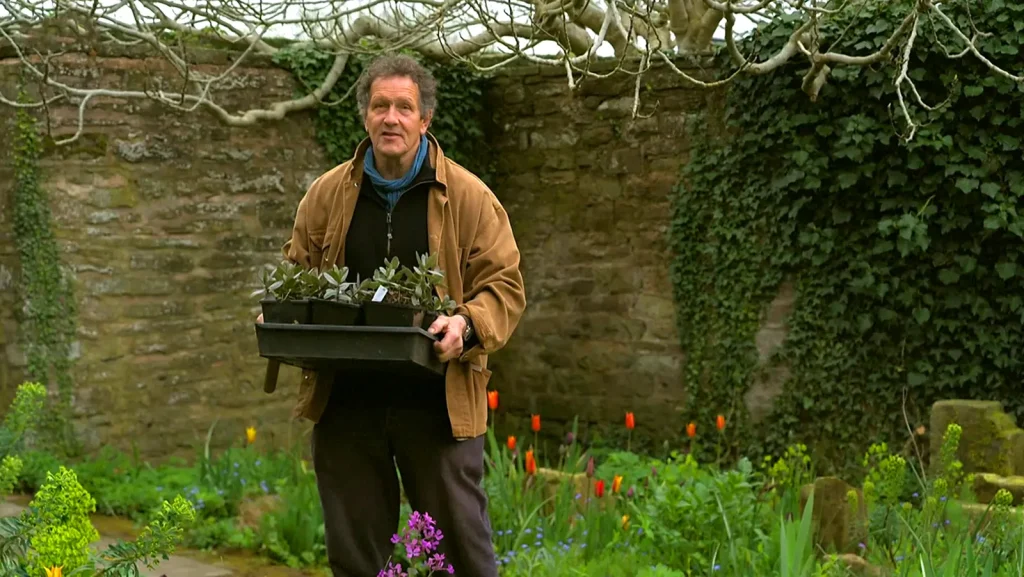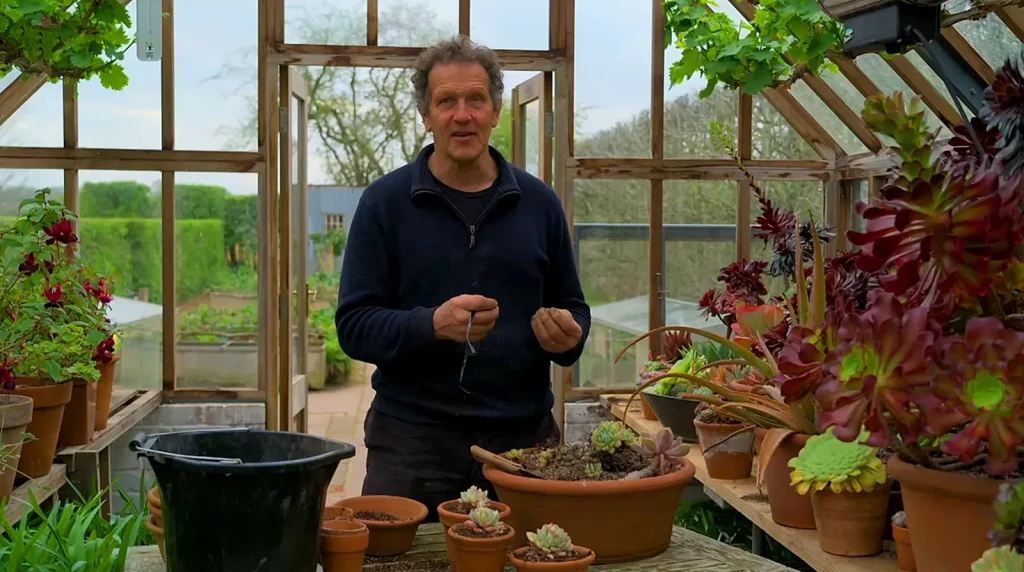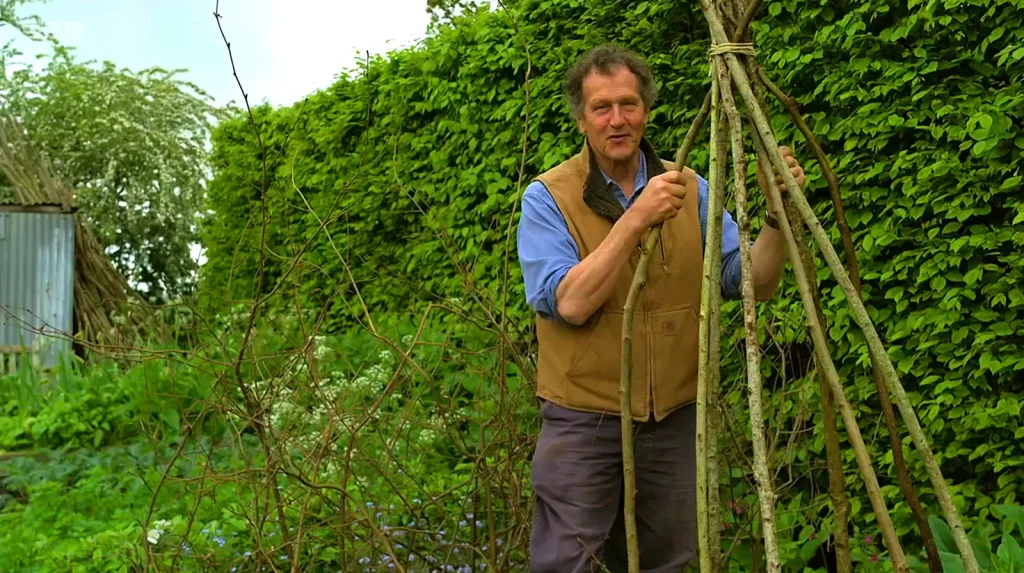Gardeners World 2024 Episode 11: With summer feasts in mind, Monty Don unveils a new outdoor dining area he has been meticulously crafting, setting the perfect stage for alfresco dining experiences. To kick off the season, he begins by planting a pot of aromatic and flavorful herbs, ensuring they will be within easy reach for summer cooking. With the last frost now a distant memory, Monty also turns his attention to planting out tender plants. These additions promise to bring vibrant color and life to the garden for months to come, creating a visually stunning and welcoming space for outdoor gatherings.
Meanwhile, Carol Klein takes us on a journey to a breathtaking garden in Oxfordshire. Here, the borders are overflowing with a dazzling array of colorful annuals, each plant contributing to a vibrant tapestry of hues. This garden is a testament to the beauty and diversity that can be achieved with careful planning and a love for gardening. Carol’s visit offers viewers a chance to appreciate the intricate details and hard work that go into maintaining such a spectacular display.
Adam Frost, on the other hand, shares his insights and the creative process behind his upcoming show garden for Gardeners’ World Live. He delves into the concepts and inspirations that drive his design, providing a behind-the-scenes look at how his vision comes to life. Adam’s explanations not only highlight his expertise but also serve as a source of inspiration for viewers who might be looking to bring a bit of his innovative spirit into their own gardens.
In Devon, an artist has dedicated the past 25 years to cultivating a garden that serves as a sanctuary for wildlife. This garden is a harmonious blend of art and nature, where every element is thoughtfully designed to support and enhance the local ecosystem. The artist’s commitment and passion shine through in every corner of this space, offering a unique perspective on how gardens can be both beautiful and beneficial to wildlife.
Additionally, we explore a remarkable collection of rhododendrons in Derbyshire, tended to by three generations of the same family. This living legacy is a testament to their dedication and love for these stunning plants. Each generation has contributed to the growth and preservation of this collection, making it a cherished family heirloom that continues to flourish year after year. The rhododendrons, with their vibrant blooms, are a highlight of the garden and a source of pride for the family.
This episode of Garden Rescue, the 15th of 2024, promises to be a rich and varied exploration of gardens and gardening. From Monty’s new outdoor dining area and herb planting to Carol’s visit to a colorful Oxfordshire garden, Adam’s show garden insights, the wildlife-friendly haven in Devon, and the multi-generational rhododendron collection in Derbyshire, there is something for every gardening enthusiast. Whether you’re looking for inspiration, practical tips, or simply a chance to enjoy the beauty of these gardens, this episode has it all.
Gardeners World 2024 Episode 11
Gardeners’ World 2024: A Season of Growth and Inspiration with Monty Don
The much-anticipated 2024 season of Gardeners’ World has bloomed onto our screens, once again led by the beloved horticultural expert, Monty Don. This season promises a rich tapestry of gardening wisdom, breathtaking landscapes, and practical advice to inspire both novice and seasoned gardeners alike.
Monty Don’s Garden Sanctuary: Longmeadow
As always, the heart of Gardeners’ World beats at Longmeadow, Monty Don’s cherished Herefordshire garden. Each episode offers a captivating glimpse into the ever-evolving beauty of Longmeadow, showcasing its diverse plantings, charming features, and the harmonious relationship between nature and design. Monty’s intimate connection to his garden shines through, as he shares his insights and experiences, inviting viewers to cultivate their own green havens.
Expert Guidance and Practical Advice
Gardeners’ World 2024 is a treasure trove of gardening expertise. Monty Don, alongside a team of passionate horticulturists and specialists, provides invaluable guidance on a wide range of topics. From planting and pruning techniques to soil health, pest control, and sustainable practices, viewers are equipped with the knowledge and skills to nurture their gardens to their full potential.
This season delves into innovative approaches to gardening, exploring the latest trends, techniques, and plant varieties. Whether it’s creating a vibrant pollinator garden, growing your own food, or embracing the beauty of wildflowers, Gardeners’ World inspires viewers to experiment, discover, and cultivate their own unique gardening styles.
Inspiring Stories and Community Connections
Beyond its practical advice, Gardeners’ World celebrates the profound impact that gardening has on our lives. Each episode features inspiring stories of individuals and communities who have transformed their surroundings through gardening, fostering connections with nature, promoting well-being, and creating spaces for joy and reflection.
Viewers are invited to join a thriving community of gardening enthusiasts. Through social media platforms and online forums, the Gardeners’ World community shares ideas, experiences, and challenges, fostering a supportive and engaging environment for gardeners of all levels.
Garden Transformations and Design Inspiration
Gardeners’ World 2024 showcases a diverse array of gardens, from grand estates to urban allotments, each offering a unique perspective on garden design and planting. Viewers are treated to stunning visuals, innovative layouts, and creative plant combinations, sparking ideas for their own garden transformations.
The season also features visits to exceptional gardens across the UK and beyond, highlighting the rich horticultural heritage and diversity of landscapes. These journeys offer glimpses into the world of garden design, showcasing innovative solutions, sustainable practices, and inspiring examples of how gardens can be tailored to specific climates and environments.
A Year-Round Gardening Companion
Gardeners’ World 2024 is a year-round gardening companion, offering guidance and inspiration for every season. From spring bulbs and summer blooms to autumn harvests and winter preparations, each episode aligns with the natural rhythms of the gardening year, providing timely advice and showcasing the beauty of each season.
Whether you are a seasoned gardener or just starting your gardening journey, Gardeners’ World 2024 promises to be a valuable resource, a source of inspiration, and a celebration of the joy of gardening. Tune in to this season’s episodes and embark on a journey of growth, discovery, and connection with the natural world.
How to Grow Bamboo: Comprehensive Guide
Discover how to grow bamboo successfully with our comprehensive guide. Learn about choosing the right bamboo, planting techniques, ongoing care, and propagation methods to ensure a thriving bamboo garden.
Choosing the Right Bamboo for Your Garden
Selecting the right bamboo variety is crucial for the success of your garden. Bamboos can be broadly categorized into two types: clump-formers and runners.
Clump-Forming Bamboos
Clump-forming bamboos grow in dense clusters and are less invasive than running types. They are ideal for gardens with limited space and can still become large plants under favorable conditions. Popular clump-forming bamboos include Bambusa, Chusquea, Fargesia, Shibataea, and Thamnocalamus.
Running Bamboos
Running bamboos produce long rhizomes that spread away from the main plant and can become invasive if not controlled. They require more space and should be planted with a physical barrier to prevent spreading. Examples of running bamboos include Arundinaria, Phyllostachys, Pleioblastus, Pseudosasa, and Sasa.
Planting Bamboo
Best Time to Plant
The optimal time to plant bamboo is in the spring. This allows the rhizomes to establish roots and produce new canes during the summer.
Ideal Planting Conditions
Bamboos prefer moist, fertile, and well-drained soil. They thrive in sheltered, sunny spots but can tolerate various soil types. Avoid waterlogged or extremely dry conditions. Enrich the planting area with well-rotted compost or manure to enhance soil fertility and moisture retention.
Planting Technique
- Dig a Hole: Prepare a hole twice the width of the rootball and deep enough for the rootball to sit slightly below the soil surface.
- Position the Rootball: Place the rootball in the hole, ensuring it sits slightly lower than it was in the container.
- Backfill: Fill in around the rootball with a mix of soil and compost, then firm in.
- Water and Mulch: Water thoroughly and apply a mulch layer to retain moisture.
Preventing Bamboo Spread
Physical Barriers
To control running bamboos, install a physical barrier:
- Dig a Trench: At least 60cm deep, ideally 1.2m deep for large plants.
- Line the Sides: Use solid barriers like paving slabs, corrugated-iron sheets, or root-barrier fabric.
- Overlap and Bond: Overlap fabric ends by at least 30cm and bond with mastic.
- Above Soil Barrier: Ensure the barrier protrudes at least 7.5cm above the soil surface to prevent spreading over the top.
Caring for Bamboo
Watering
- Newly Planted Bamboos: Water regularly during dry spells in summer.
- Container Plants: Water regularly and liberally throughout the growing season as they dry out faster.
Feeding
- General Purpose Feed: Apply a granular feed in spring, especially on poor, light soil.
- Container Bamboos: Use a general liquid feed from March to October.
Pruning and Maintenance
- Show Off Canes: Remove lower foliage to display attractive canes.
- Thin Out Clumps: Cut weak, dead, or damaged canes in spring. Thin dense clumps to allow light and air circulation.
- Height Control: Prune tops to contain height and encourage lush foliage.
Propagating Bamboo
Division
Divide bamboo in mid-spring:
- Lift and Split: Use a mattock or axe for dense clumps and a saw for smaller ones.
- Replant Young Rhizomes: Use younger rhizomes towards the clump’s outside for new plants.
Rhizome Cuttings
Take rhizome cuttings in early spring:
- Select a Young Cane: Choose one on the clump’s outside.
- Uncover and Sever: Dig to expose the rhizome, sever, and lift the cutting.
- Prepare and Plant: Reduce cane height, place rhizome in gritty compost, water, and cover with plastic to retain humidity.
- Indoor Care: Keep in a warm, bright location and plant out the following spring.
How to Start a Lawn from Seed: A Comprehensive Guide
Establishing a lush, green lawn from seed is cost-effective and straightforward. Follow our detailed guide to choose the right seed mix, prepare your site, sow the lawn, and care for it to ensure beautiful results. Perfect for spring and autumn sowing.
Why and When to Sow a Lawn from Seed
Growing a lawn from seed offers numerous advantages over using turf. It’s more affordable, offers a wider variety of seed mixes to suit different conditions, and seeds are easier to transport and store until the weather is ideal for sowing. While establishing a lawn from seed takes longer, the process is straightforward and rewarding.
Optimal Sowing Seasons
Lawn seeds germinate best in early autumn (September to November) and mid-spring (March to April). During these periods, the soil remains warm, moisture levels are sufficient, and temperatures are moderate, promoting quick germination within seven to ten days. Early autumn is particularly advantageous as seedlings establish before the first frosts and root well through winter. In spring, grass might grow slower as it focuses on flowering.
Choosing the Right Seed Mix
Selecting the appropriate seed mix is crucial for creating a lawn that meets your needs and thrives in your specific conditions.
General-Purpose Lawn
A mix of hard-wearing grasses suitable for areas with heavy foot traffic, children, and pets. Typically includes perennial ryegrass, tall fescue, red fescues, and browntop. This blend grows fast and requires regular mowing.
Luxury or Fine Lawn
A blend of fine-leaved turf grasses that create a dense, soft lawn. Commonly includes Chewing’s fescue, strong and slender creeping red fescue, and browntop. These slow-growing grasses can be mowed at a low height for a neat appearance.
Shady Lawn
Ideal for light to medium shade areas, such as under trees or beside fences. Usually contains hard fescue, strong and slender creeping red fescue, and browntop. These fine-leaved grasses are less robust but suitable for shaded spots.
Additional Seed Mixes
Other available mixes cater to specific needs such as drought tolerance, low maintenance, or quick establishment. Examine the ingredients as they often resemble the primary options mentioned above.
Top Tip: Buy Quality Seed
Invest in reputable brands to avoid low-quality seed mixes that might contain weeds or coarse grasses. Ensure any perennial ryegrass listed is either ‘turf’ or ‘fine’ ryegrass for the best results.
Preparing Your Sowing Site
Proper preparation of the sowing site is essential for achieving a top-quality lawn that is level, dense, well-rooted, and weed-free.
- Remove Perennial Weeds: Clear all perennial weeds, such as couch grass and bindweed, well in advance. Dig out their roots or use a weedkiller (avoid residual weedkillers).
- Soil Preparation: If the soil is compacted, dig or rotovate to a depth of about 20cm (8 inches). For light, fast-draining soils, add well-rotted manure or compost to improve moisture retention.
- Settling the Soil: After digging, allow the soil to settle for several days to several weeks. Weed again if necessary.
- Firming the Soil: Tread the area in different directions using small, shuffling steps to firm the soil.
- Raking: Thoroughly rake the surface to create a level seedbed, removing stones and breaking up clumps of earth.
- Fertilizing: Optionally, rake in a general-purpose fertilizer at a rate of 70g (2oz) per square meter.
How to Sow a Lawn
Sowing a lawn requires careful attention to ensure even distribution of seeds.
- Measure Seeds: Calculate the required seed quantity based on the area. Divide the seeds into two equal batches.
- First Batch: Sow the first batch by walking up and down in parallel rows, scattering seeds evenly.
- Second Batch: Sow the second batch by walking side to side, ensuring thorough coverage.
- Raking: Lightly rake the area to cover most seeds with soil.
- Watering: If no rain is forecast, water gently with a light spray to avoid dislodging seeds.
- Protecting Seeds: Cover the area with horticultural fleece or use bird tape to protect from birds and enhance germination.
Looking After a New Lawn
To ensure the successful establishment of your new lawn, follow these care tips:
- Watering: Regularly water seedlings if it doesn’t rain, using a gentle spray.
- Firming the Soil: When seedlings reach 5–7.5cm (2–3 inches), lightly firm the soil with a garden roller or the rear roller of a mower.
- First Mow: Cut the grass after a few days, reducing height by only one-third. Use a sharp cylinder-bladed mower.
- Subsequent Mowing: For autumn-sown grass, additional mowing is usually not needed until spring. For spring-sown grass, mow weekly as required, gradually lowering the blade height.
- Weeding: Hand-weed any perennial weeds. Avoid using lawn weedkillers on new lawns for the first six months to a year.
- Minimize Usage: Limit lawn use for about eight months. Avoid using autumn-sown lawns before June and spring-sown lawns until late autumn.
- Addressing Dips: Fill any dips with a thin layer of sieved compost.
F.A.Q. Gardeners World 2024 Episode 11
Q.: What can viewers expect from Monty Don in Gardeners’ World 2024 Episode 11?
A.: In Episode 11, Monty Don reveals a new outdoor dining area he has been crafting, perfect for alfresco dining. He also plants a pot of aromatic and flavorful herbs to enhance summer cooking and begins planting out tender plants to bring vibrant color and life to the garden.
Q.: What is Carol Klein’s contribution in this episode?
A.: Carol Klein visits a stunning garden in Oxfordshire, showcasing borders overflowing with colorful annuals. She highlights the meticulous planning and love for gardening that contribute to this vibrant display, offering viewers a chance to appreciate the intricate details of maintaining such a garden.
Q.: How does Adam Frost inspire viewers in this episode?
A.: Adam Frost shares insights into his creative process for his upcoming show garden at Gardeners’ World Live. He delves into the concepts and inspirations behind his design, providing a behind-the-scenes look that inspires viewers to incorporate his innovative ideas into their own gardens.
Q.: What unique garden is featured from Devon in this episode?
A.: In Devon, the episode features an artist’s garden that has been cultivated over 25 years to serve as a wildlife sanctuary. This garden is a harmonious blend of art and nature, thoughtfully designed to support the local ecosystem, showcasing the artist’s passion and commitment to both beauty and wildlife.
Q.: What special collection is highlighted in Derbyshire?
A.: The episode highlights a remarkable collection of rhododendrons in Derbyshire, tended to by three generations of the same family. This living legacy demonstrates their dedication and love for these stunning plants, with vibrant blooms that are a source of pride and a cherished family heirloom.
Q.: What is the overall theme of Gardeners’ World 2024 Episode 11?
A.: The overall theme of this episode is a rich and varied exploration of gardens and gardening. From Monty’s new outdoor dining area and herb planting to Carol’s visit to a colorful Oxfordshire garden, Adam’s show garden insights, the wildlife-friendly haven in Devon, and the multi-generational rhododendron collection in Derbyshire, the episode offers something for every gardening enthusiast.




